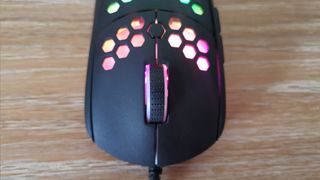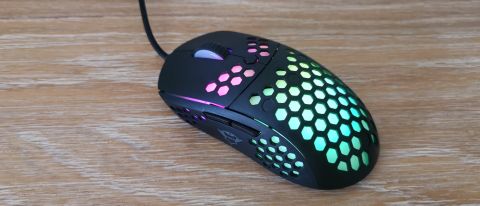TechRadar Verdict
It's a pretty mouse to look at, but the Trust GXT 960 Graphin can’t win us over on looks alone. While it’s incredibly light, the thick cable and disappointing functionality mean it’s not a great choice for the types of games it’s been designed for.
Pros
- +
Modern Honeycomb design
- +
Very lightweight
- +
RGB lighting is always a nice touch
Cons
- -
The mouse cord is unwieldy
- -
Very little functionality
- -
Fragile build
Why you can trust TechRadar
Two-Minute Review
We're a sucker for anything that lights up – if you can shove RGBs into it and smother it with programmable effects then you’ve got our attention. Sadly, when testing the Trust GXT 960 Graphin gaming mouse we were reminded that fancy lighting isn’t actually everything.
The Trust GXT 960 Graphin is available in the UK priced at £29.99. It would appear that currently, you can only purchase the GXT 960 Graphin in the UK and Europe, and Trust hasn’t confirmed whether it will go on sale in the US or Australia, but that UK price works out to around $40 or AU$55.
The mouse itself is fairly small, likely due to Trust looking to keep the weight down, but this does mean it's not particularly suitable for larger hands. Size aside, the only two side buttons on the GXT 960 Graphin feel oddly placed, and reaching them requires some less-than-intuitive hand placement – and you have to bear in mind that super-lightweight mice such as this one are designed with quick reactions in mind. Their placement also means the GXT 960 Graphin is only suitable for right-handed users, so lefties will need to look elsewhere.

This wasn’t the only poor design choice made by Trust, with the main mouse buttons being too flimsy and close together. This resulted in frequent miss-clicks and grinding that made playing games like Apex Legends or Valorant a complete nightmare. With players of first-person-shooter titles being the common genre targeted by lightweight gaming mice, it’s a little frustrating that this product would actually serve as more of a hindrance than any help.
In fact, ‘frustrating’ is likely the best description we have for the Trust GXT 960 Graphin. If you’re desperate for something with pretty rainbow lights and an attractive design then it’ll sit very nicely on your desk, but it struggles at the basics of moving well and clicking. There are other incredible gaming mice on the market worth buying on a tight budget, but if you have a little extra cash to burn then investing in something like the Razer Viper will save you a lot of stress
Design

The Trust GXT 960 Graphin certainly ticks our box for having nice lighting effects, and the honeycomb design, being a fairly recent trend, gives it a modern look. Other gaming mice notable for having this hexagonal design are the SteelSeries Aerox 3 and the Cooler Master MM710 (if you’re enticed by the styling, but not the results of our review). The overall aesthetic is rather lovely, and the RGBs can be programmed in the downloadable software, which you also use to assign hotkeys. It looked right at home amongst our dragon’s hoard of black RGB gaming peripherals and accessories.
True to the description on the box, the GXT 960 Graphin is extremely light, weighing in at just 74g / 2.6oz so it's unlikely you’ll be giving yourself hand strain from long hours in a fast-paced game. It has the maxiumum 10,000 DPI expected of most gaming mice too, so you won’t need to fling your arm across your desk in order to make trick shots.
The Trust management software doesn’t have many bells and whistles, but that's a refreshing change to the sometimes complicated programs used by other brands. You can change the light sequence, allocate gaming profiles and adjust the DPI sequence with very little fuss. There’s only one DPI button on the mouse itself, so creating your own sequence to scroll through will help those who change it up during game matches.
Performance

Unfortunately, the effort that Trust has put into making the GXT 960 Graphin super-light is undermined by design decisions elsewhere. While the mouse itself is a dainty little thing, the corded cable is extremely unwieldy, and it’s not much use having a lightweight mouse if you're having to expend serious energy coaxing the cable into the required direction. Not only is it heavy, it’s incredibly stiff, and no amount of time spent ‘massaging’ the cord helped to improve its softness or flexibility.
There have also been a few design sacrifices made in the name of keeping the weight down. The plastic shell of the GXT 960 Graphin is necessarily very thin, but the overall feeling is just… flimsy. When you flip the mouse over, the near-opaque plastic shell housing the guts of the mouse and the lighting hasn’t been extended, leaving an exposed view into the housing. Again, this is likely due to the need to eliminate unnecessary weight, but the resulting look isn’t pleasant.

The functionality of the GXT 960 Graphin also suffers as a result of these compromises, with the main buttons feeling brittle and sometimes grinding against each other due to having no spacing between them. As mentioned, there are only two side buttons that you can program with your required hotkeys, and these remained stiff even after we’d been using the mouse for a few days. The Teflon pads on the underside do make for a smooth action when you’re dragging the mouse across both fabric and hard mousepads though, and the scroll wheel on the mouse has a rubber grip, and offers good resistance for precision zooming or page scrolling.
When we used the GXT 960 Graphin for gaming, the resistance from the cord coupled with the uncomfortable buttons made for a very disappointing experience. We weren't always focused on what we were playing, as we were often wrestling with the buttons and cursing under our breath.
We also found that we could barely hit the buttons with our fingers, let alone use them effectively. We’ll admit to feeling a sense of relief when we put the GXT 960 Graphin back in its box and could go back to just enjoying games with the distractions.
If you’re happy to ‘wear in’ the monstrous cable and aren’t bothered by products that feel plasticky then you may find the Trust GXT 960 Graphin to be a suitable gaming mouse; otherwise, save up a few extra pennies and look elsewhere.
Buy it if...
You’re really set on a lightweight mouse
The GXT 960 Graphin weighs in at just 74g / 2.6oz, which does make it very light to the touch. If you need a mouse that won't exacerbate issues with your hand then this might be a good choice.
You’re on a budget
At just £29.99 (around $40, AU$55), this is a cheap mouse with some nice gaming aesthetics. If your options are limited then the price is pretty hard to beat for the look.
You don’t want a lot of buttons to worry about
With only two programmable side buttons, this mouse won’t overwhelm you with hotkey demands, and their placement also means you’re not at risk of accidentally clicking them with a stray thumb.

Don't buy it if...
You need to hotkey in games
This mouse only has two programmable buttons for your hotkeys, which will be very restrictive in many gaming environments.
Precision is important to you
Despite the GXT 960 Graphin being so lightweight, you’ll spend much of your play sessions fighting against the heavy corded cable and sticky buttons.
You can stretch your budget
We cannot stress this enough: if you’re not on a budget then there are way better gaming mice out there, many of which aren’t that much more expensive.
Jess is a former TechRadar Computing writer, where she covered all aspects of Mac and PC hardware, including PC gaming and peripherals. She has been interviewed as an industry expert for the BBC, and while her educational background was in prosthetics and model-making, her true love is in tech and she has built numerous desktop computers over the last 10 years for gaming and content creation. Jess is now a journalist at The Verge.


